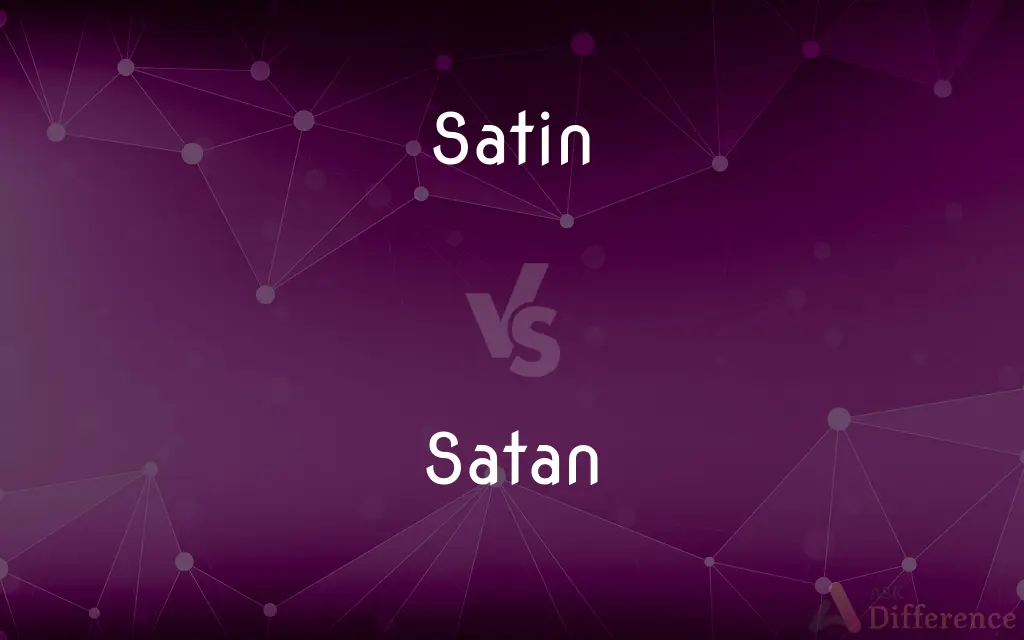Satin vs. Satan — What's the Difference?
By Maham Liaqat & Urooj Arif — Updated on February 22, 2024
Satin is a smooth, glossy fabric known for its luxurious feel, commonly used in fashion and upholstery. Satan, in contrast, is a figure often associated with evil and temptation in various religious texts, notably in Christianity.

Difference Between Satin and Satan
Table of Contents
ADVERTISEMENT
Key Differences
Satin, a textile characterized by its lustrous surface, is produced using specific weave techniques that leave fewer interlacings on the fabric surface, resulting in its distinctive sheen. This fabric is favored for its smooth texture and aesthetic appeal, making it a popular choice for evening wear, bridal gowns, and interior decorations. Satin can be made from silk, polyester, or other fibers, offering various levels of quality and feel.
Satan, on the other hand, is a figure rooted in religious lore, primarily known as a symbol of evil, rebellion, and temptation. In Christian theology, Satan is often depicted as a fallen angel who opposes God and is a central figure in the narrative of temptation and sin. This entity is portrayed in various religious and cultural texts, embodying the concept of moral struggle and the embodiment of evil.
The difference between satin and Satan extends beyond their spelling and pronunciation; they occupy entirely different realms of discourse. Satin is discussed in contexts related to fashion, textiles, and material luxury, emphasizing physical and aesthetic qualities. In contrast, Satan is a topic within theological, moral, and philosophical discussions, representing abstract concepts of good versus evil, moral temptation, and spiritual warfare.
Satin conveys notions of elegance, sensuality, and sophistication due to its physical attributes, while Satan invokes themes of morality, ethics, and spiritual conflict. The former is tangible, associated with sensory experiences and material craftsmanship, whereas the latter is intangible, often serving as a symbol or metaphor in religious and cultural narratives.
Understanding the distinction between satin and Satan is crucial for clear communication, as confusing one for the other could lead to significant misunderstandings given their vastly different associations and contexts.
ADVERTISEMENT
Comparison Chart
Nature
Textile/Fabric
Mythological/Religious Figure
Context
Fashion, Upholstery, Textiles
Religion, Mythology, Ethics
Characteristics
Smooth, Glossy Surface
Embodiment of Evil and Temptation
Usage
Clothing, Bedding, Interior Decor
Symbolic in Religious Texts and Teachings
Associated Terms
Luxury, Elegance, Sheen
Sin, Temptation, Rebellion
Compare with Definitions
Satin
A weave that typically has a glossy surface and a dull back.
The bride's gown was crafted from the finest silk satin.
Satan
A figure often associated with evil in religious texts.
Satan is depicted as the tempter in the Garden of Eden.
Satin
Reflective and lustrous textile.
The satin ribbon shimmered under the gala's lights.
Satan
A representation of rebellion against divine order.
Satan's fall from grace is a story of pride and rebellion.
Satin
Material choice for formal wear.
Satin ties and lapels are staples in evening wear.
Satan
Central to narratives of spiritual warfare.
Many religions include the struggle against Satan in their teachings.
Satin
Fabric known for its smooth texture.
The satin sheets added a touch of luxury to the bedroom.
Satan
Embodiment of the concept of evil.
Folklore often personifies evil as Satan in various guises.
Satin
Used in various apparel and decor.
The designer favored satin for its elegant drape and sheen.
Satan
Symbolic of temptation and moral failure.
In literature, characters often face their Satan in moments of moral crisis.
Satin
A smooth, often silk fabric that is woven with a glossy face and a dull back.
Satan
In Abrahamic religions, a powerful spiritual being, the tempter and persecutor of humanity, sometimes considered as an angel who rebelled against God and became the Devil.
Satin
A silk cloth, of a thick, close texture, and overshot woof, which has a glossy surface.
Cloths of gold and satins rich of hue.
Satan
The grand adversary of man; the Devil, or Prince of darkness; the chief of the fallen angels; the archfiend.
I beheld Satan as lightning fall from heaven.
Satin
A garment made of this fabric.
Common Curiosities
Can Satan be depicted positively in any context?
While traditionally viewed negatively, some literary and cultural interpretations explore more complex or symbolic representations of Satan.
Is satin only made from silk?
No, satin can be made from silk, polyester, nylon, and other fibers, affecting its feel and appearance.
What is the origin of the figure of Satan?
Satan's origins can be traced to Abrahamic religions, with varying interpretations and roles within each tradition.
What makes satin suitable for formal attire?
Its smooth texture and elegant sheen make satin a popular choice for formal and evening wear.
Is Satan a universal figure in all religions?
No, the concept of Satan and his role vary significantly across different religions and belief systems.
Are there different types of satin?
Yes, there are various types of satin, including charmeuse, duchesse, and slub satin, each with unique characteristics.
Can satin finishes be found in products other than textiles?
Yes, "satin" can also refer to a type of semi-gloss finish in products like paint and metalwork.
Can satin be used for casual wear?
While often associated with luxury, satin can also be used in more casual and everyday apparel, depending on the garment's design.
Does the depiction of Satan vary between cultures?
Yes, cultural interpretations of Satan can vary widely, influencing how this figure is represented in art, literature, and folklore.
What psychological role does Satan play in religious teachings?
Satan often serves as a symbol for the internal and external struggles against temptation and moral wrongdoing.
How has the artistic representation of Satan evolved?
Artistic depictions of Satan have evolved from medieval iconography to modern interpretations that reflect changing cultural and theological perspectives.
How is satin fabric cared for?
Satin requires careful handling, often needing gentle washing or dry cleaning to maintain its texture and sheen.
How is Satan portrayed in modern media?
In modern media, Satan is often portrayed in a variety of ways, from the traditionally malevolent to more nuanced or metaphorical roles.
What lessons are typically associated with Satan in religious contexts?
Teachings involving Satan often focus on themes of resistance to temptation, moral integrity, and the consequences of evil actions.
Is there eco-friendly satin?
Eco-friendly options include satin made from recycled materials or sustainable fibers like bamboo satin.
Share Your Discovery

Previous Comparison
Total vs. Gross
Next Comparison
Participator vs. ParticipantAuthor Spotlight
Written by
Maham LiaqatCo-written by
Urooj ArifUrooj is a skilled content writer at Ask Difference, known for her exceptional ability to simplify complex topics into engaging and informative content. With a passion for research and a flair for clear, concise writing, she consistently delivers articles that resonate with our diverse audience.















































